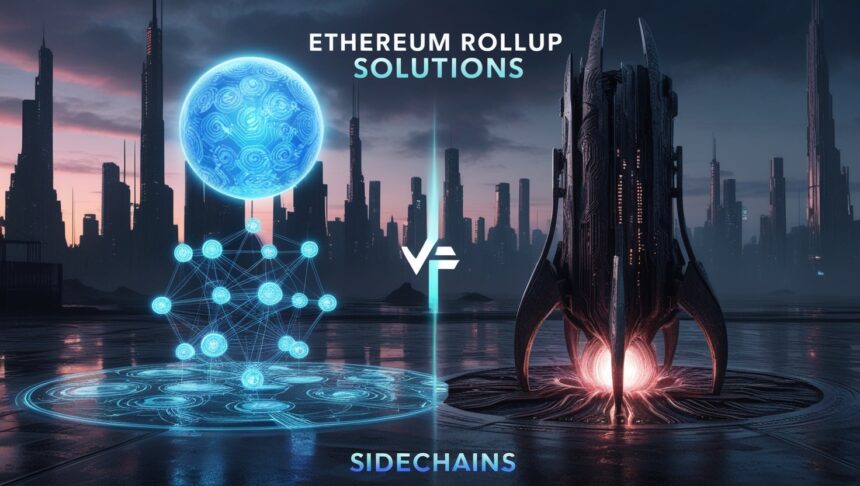In this article, I will explain the Ethereum Rollup Solutions vs Sidechains. Both technologies provide scalability solutions for Ethereum, albeit in different manners.
I will discuss how rollups utilize Ethereum’s security while sidechains allow greater granularity and control, illuminating their particular advantages, difficulties, and possible applications in the blockchain industry.
What is Ethereum Rollup Solutions?
Ethereum rollups are a type of Layer 2 scaling solution that seeks to enhance the transaction speed and decrease the costs incurred on the Ethereum Network.
Processing transactions off-chain and later “rolling up” or condensing them into one transaction that is sent to the Ethereum Mainnet is how these solutions function.

This method enhances gas fee savings and congestion while still assuring security through data availability, fraud or validity proof, and Ethereum’s distinctive features.
Optimistic rollups and zero-knowledge (ZK) rollups are the two principal types of rollups, each differentiated by its way of verifying transactions.
What Is Sidechains?
Sidechains are distinct blockchains which run parallel to the Ethereum mainnet with the goal of improving scalability and functionality.
They’re self-contained chains with their own consensus mechanisms, linked to Ethereum via a two-way bridge, enabling the transfer of assets and information across the chains.

This fast Sidechain can complete transaction at a record low cost, but unlike the Ethereum network, lacks prime security owing to dependance on civil validators.
As a result, they are nimble for tailored solutions, but might be more susceptible to risks than Layer 2 rollups.
How Rollups work?
The execution of transactions on Ethereum’s mainnet is done off-chain which is followed by posting the transaction summary on the chain.
The ‘rollup’ as defined in the previous sentence is a summary that includes all transaction data as well as compressed data representing various transactions which helps lower the burden on Ethereum’s base layer.
Optimistic rollups use fraud proofs while ZK-rollups use validity proofs to make sure that off-chain transactions are accurate.
This solution enhances scalability, reduces gas fees, and preserves the security model of Ethereum because the mainnet retains the final settlement and provides access to the data.
How Sidechains work?
“Sidechains are separate blockchains that interface with the Ethereum network via a two-way bridge. Each sidechain has its own consensus mechanism and it independently validates and processes transactions without needing the main chain of Ethereum.
Resources can be moved from the sidechain to the mainnet and vice versa through this bridge. Although sidechains provide better scalability and efficiency than the other Ethereum network, it does not inherit the same level of security like the Ethereum main chain. It instead relies on the sidechain’s own validators to maintain the integrity of each transaction.
Key Differences Between Rollups and Sidechains
| Feature | Rollups | Sidechains |
|---|---|---|
| Security Model | Inherits security from Ethereum through on-chain data and proofs | Relies on its own consensus mechanism, not Ethereum’s |
| Transaction Processing | Processes transactions off-chain, posts data on Ethereum | Processes transactions independently on its own chain |
| Scalability & Fees | More efficient with lower fees due to Ethereum integration | Offers lower fees, but scalability depends on the sidechain |
| Interoperability | Tightly integrated with Ethereum, uses on-chain data availability | Uses a two-way bridge for asset transfer with Ethereum |
| Complexity | More complex due to fraud/validity proofs and data management | Simpler to implement but less secure due to independent consensus |
”What Are Sidechains Best For?
Both sidechains and layer 2 (L2) rollups possess specific advantages and use case offers within the pauses in the blockchain cosmos. While L2 rollups aim at enhancing scalability with compatibility to layer 1, sidechains employ a different strategy to achieve simliar goals.
Sidechains serve best for hosting decentralized apps (dApps) that need custom features that the main blockchain does not provide. This might range from trying out new consensus algorithms and governance systems, to even designing proprietary languages for smart contracts.
Ethereum Rollup Solutions Challenges and Limitations
While rollups enhance Ethereum’s scalability, they also introduce new challenges:
Data Availability: Rollups depend on the Ethereum layer 1 chain for data availability; if there are issues retrieving or trusting this data, rollups can have problems with finality or even with trustless invalid transaction broadcasting.
Latency: Rollups combining off-chain transactions will post them in chunks, which may result in latency for real-time applications needing fast processing.
Fraud Proof Complexity: While optimistic rollups rely on fraud proofs and ZK rollups utilize validity proofs, the infrastructure needed poses complex implementation challenges. This may lead to reduced maintainability of rollup solutions.
Limited Cross-chain Interoperability: Despite the rollup’s ability to scale the transaction throughput on Ethereum, off-chain interoperability with other blockchains (or Layer 2 solutions) could be constraining for projects that seek broad cross-chain engagement.
Security Impact with Optimistic Rollups: Validators exposing false transactions undergo payment of challenge costs, guarding fraud proofs. Continuous exploitation can endanger the system since claiming proofs can take time while costs mount.
Costs of On-chain Data Posting: Even though rollups lower gas prices, there are still some fees associated with posting transaction data to Ethereum, which may pose problems in times of high congestion on the Ethereum network.
Sidechains Challenges and Limitations
Security Risks: Sidechains have their own consensus systems, meaning they lack the same security guarantees as Ethereum. Should the sidechain’s validators be taken over or go offline, the assets and transactions residing on that sidechain could be jeopardized if those validators go down.
Centralization: A number of sidechains utilize a more concentrated pool of validators than Ethereum’s distributed network. This could result in the loss of decentralization and trustworthiness of the sidechain.
Interoperability Issues: Although sidechains provide two-way bridging access to Ethereum, executing the transfer of assets between the sidechain and the mainnet can be intricate. These bridges could be susceptible to some form of attack and have limited cross-chain interoperability.
Scalability Bottlenecks: As the name suggests, sidechains are meant for scalability, but unmanaged high traffic could lower their performance. This could result in increased congestion, higher fees, and prolonged transaction approval durations on that sidechain.
Governance Complexity: With varying degrees of mitigation options, sidechains seemingly possess their own governance models which can be overly opaque when compared to Ethereum’s governance framework. This could create conflict among various sides with differing interests and slower processes.
Maintenance and Upgrades: Because sidechains operate independently, they require perpetual maintenance and upgrades. Without proper maintenance, sidechains can suffer from network failure or other problems that could threaten the system.
Future Outlook Ethereum Rollup Solutions
The future scope of rollup solutions for Ethereum is very positive, since adoption of DeFi and dApps is growing. Their transaction speed, cost, and efficiency will improve while still securing Ethereum with rollups.
Ethereum will have its scalability worked on, and the advancement of ZK rollups will assist during these high-demand periods to lessen latency and improve responsiveness.
Other blockchains will be able to access these rollups, further assisting the multi-chain ecosystem which will create a more efficient and cohesive environment.
The evolution of these rollup solutions will allow Ethereum to sustain prolonged growth and popularity.
Future Outlook Sidechains
The prognosis for sidechains appears highly optimistic, particularly from the vantage of their impact on Ethereum’s flexibility and scalability. As blockchain technology progresses, it is expected that specific use cases will be addressed using sidechains with more speed and lower costs, leading to increased adoption.
Innovations in governance models and consensus processes will further enhance their security, making them more competitively advantageous in comparison to Ethereum’s mainnet and Layer 2 alternatives.
Moreover, these sidechains will probably achieve greater interoperability with other blockchains for more seamless transfers of cross-chain assets and improvement of multi-chain ecosystems.
Although issues like security and decentralization pose challenges, the development of sidechains represents a fundamental shift in blockchain technology infrastructure.
Conclusion
To wrap up, both Ethereum rollups and sidechains present meaningful advancements in scalability, albeit with some differences in security, the level of complexity, transaction throughput, and more.
Rollups benefit from Ethereum’s security framework where data availability and fraud-proof systems, which are more advanced, make them optimal for applications with high demand.
Sidechains, on the contrary, offer more flexibility and lower costs of transactions, although struggle with matters of security, centralization, and degree of network control.
In the end, the decision to go with rollups or sidechains is reliant on particular use cases; it is more probable that rollups are helpful for applications that need advanced security and interoperability,
While sidechains serve as a solution that is adaptable for set requirements of a certain blockchain. In any case, both technologies stand to be very important in the future scalability developments of Ethereum.










